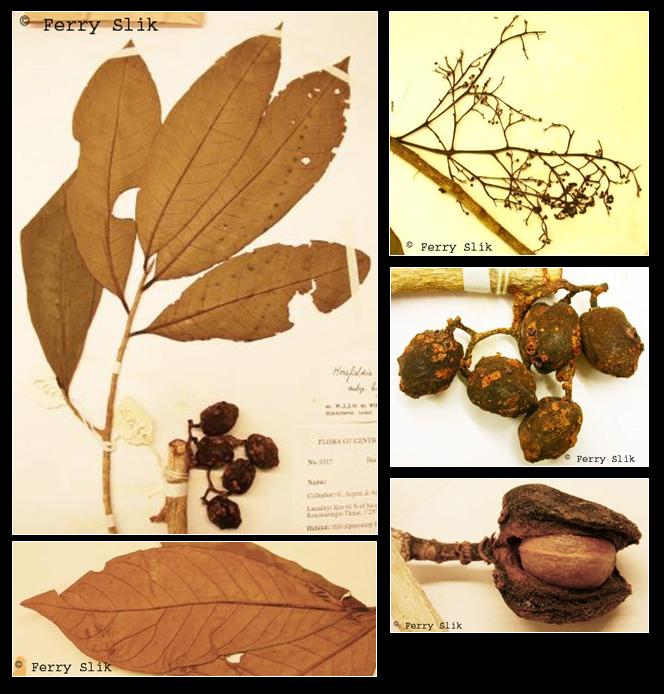Horsfieldia sucosa (King) Warb., Mon. Myrist. (1897)
Latin for 'juicy'.Synonyms
Horsfieldia bracteosa Henderson
Horsfieldia bracteosa var. bracteosa J.Sinclair
Myristica sucosa King
Diagnostics
Mid-canopy tree up to 35 m tall and 47 cm dbh. Stem with red sap. Twigs
usually conspicuously whitish. Stipules absent. Leaves alternate, simple, penni-veined,
glabrous. Flowers ca. 1 mm diameter, yellow-orange, placed in panicles. Fruits
ca. 23 mm long, yellow-pink-brownish, glabrous, dehiscent capsules. Seeds with
undivided aril.
Note
When sterile, often confused with Dehaasia (Lauraceae).
Description
Tree 6-20(-35) m tall. Twigs 2-10 mm diameter, (whitish) grey-brown or straw-coloured, contrasting
with the blackish colour of the dried petioles, early glabrescent, at first with
rusty or greyish hairs 0.1-0.3 mm long; bark coarsely striate or not, with a tendency to
flake; lenticels conspicuous only on the very young parts. Leaves in 2 or 3 rows, membranous
to thin-chartaceous, elliptic-oblong to oblong-(ob)lanceolate, 14-28 by 4.5-8.5
cm, base (long-)attenuate, apex acute-acuminate; upper surface glabrous, drying greenish
to blackish brown, lower surface early glabrescent, drying light brown; dots absent,
but scattered smaller blackish points often present; midrib +/- flat above, glabrous; nerves
13-17 pairs, slender, flat or slightly raised above, lines of interarching indistinct; venation
lax, faint; petiole 10-20 by 2-3 mm; leaf bud 10-15 by 2-3 mm, with rusty to
greyish brown hairs 0.1-0.3 mm long. Inflorescences behind the leaves, thinly pubescent
or late glabrescent, hairs 0.1-0.2 mm long; in male: 3 or 4 times branched, many flowered,
lax or condensed, 7-19 by 5-16 cm, peduncle 1-2 cm long, flowers in clusters
of 3-7; in female rather few-flowered, 1-2 cm long; bracts +/- ovate-elliptic to lanceolate,
acutish. pubescent, 1.5-4 mm long, late caducous; flowers with perianth either mostly
2-lobed (Borneo) or mostly 3-lobed (Sumatra, Peninsular
Malaysia), glabrous, pedicel slender, usually glabrous, articulated,
contrasting with the pubescent branches of the inflorescence. Male flowers: pedicel
1-2 mm long; buds (depressed) globose, apex +/- flat to broadly rounded, 1.2-1.5 by
1.5-2 mm, cleft 1/3-1/2, when dry not or slightly collapsed at the apex, lobes 0.2-0.3
mm thick; androecium depressed globose, 0.3-0.6 by 0.8-1.2 mm, circular or (in Borneo)
broadly ellipsoid in cross section; thecae 14-22, completely sessile
with +/- incurved apex, column broad, +/- saucer-shaped, with broad, flattish, apical hollow
to nearly halfway; androphore rather narrow, 0.1-0.3 mm long. Female flowers:
pedicel 1-1.5 mm long, when young with minute hairs 0.1 mm long or less
towards the base; buds broadly ellipsoid, 2.8-3.5 by 2.2-3 mm, 2-lobed, cleft c. 1/4;
ovary 1.5 mm diameter, glabrous, stigma shallowly 2-lobed, 0.1 mm high. Fruits 1-4
per infructescence, broadly ovoid-ellipsoid, apex +/- narrowly rounded, 2.3-3.5 by 2-2.5
cm, glabrous, drying blackish, finely granulate, sometimes +/- tuberculate; pericarp 4 mm
thick; fruiting pedicel 1-2 mm long; perianth in Peninsular Malaysia persistent.
[from Flora Malesiana]
Ecology
In undisturbed mixed dipterocarp and coastal forests up to 800 m altitude.
Often on alluvial sites near or along rivers and streams, but also on hillsides
and ridges. On sand and limestone soils.
Uses
The wood is locally used. The fruit is edible.
Distribution
Peninsular Malaysia, Sumatra, Borneo.
Local names
Borneo: Darah-darah, Kumpang.
